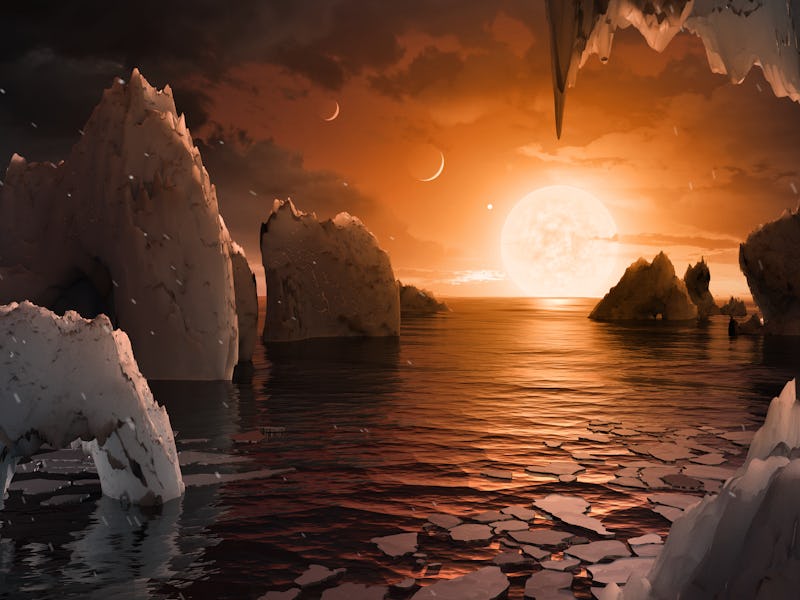These Planets Make Alien Migration (Relatively) Easy
The crowded Trappist planets might share life.

If you stood on one of the seven known planets in the Trappist star system and stared up at the sky, there’s a good chance that you would see the neighboring planet’s clouds, and perhaps even its craters, valleys, and mountains.
The planets in the Trappist solar system are so close to each other, it’s likely that if primitive life existed on one planet, it could naturally migrate to its planetary neighbors, perhaps by rocks ejected into space. Since it’s discovery in early in 2017, the Trappist star system, 40 light years from Earth, has whipped up astronomical intrigue. Of the seven known planets, three dwell within the system’s habitable zone, a region where liquid water, perhaps oceans, could slosh around the surface. Scientists did the math and determined that if one host planet harbored life, the likelihood of microorganisms naturally colonizing another Trappist planet is 100 times greater than the chance of life hopping between Mars and Earth.
And the potential for life existing on one of the Trappist planets doesn’t seem too improbable.
“You have three rolls of the dice for life there,” Avi Loeb, a Harvard astrophysicist and coauthor of the study, told Inverse. The study was published this week in the Proceedings of the National Academy of the Sciences.
Viewing planets from Trappist - 1e.
Although Loeb is unsure about the prevalence of smart aliens in the universe, he has little doubt that planets can host simple, relatively unsophisticated life, like bacteria. “My view is that we are not special and that primitive life is likely to exist around many stars — but in terms of intelligent life, this is more uncertain,” says Loeb.
The primary factors in Loeb’s algebra were the amount time a rock laden with (terrified) microorganisms would take to get another planet and the chances that this rock would hit its planetary target. The crowded Trappist planets all occupy a piece of real estate that is closer to its cooler, dwarf star than Mercury is to the sun, substantially increasing the odds of this occurring.
As for launching chunks of planetary matter into space, “There’s a chance of ejecting rocks anytime you have a big enough impact,” says Loeb. And as the surface of the moon can attest, solar systems are basically long histories of things smashing into to each other, and still today bits of asteroids and comets regularly pass through Earth’s atmosphere.
The greater concern, however, is whether or not life could survive the short journey through frigid space. Loeb says that if Earth’s minuscule, six-legged water bears, also called tardigrades, can manage to survive the callous rigors of space, then life elsewhere certainly could. Loeb cites a French mission that took a group of water bears into space and found that half of them were still able to produce viable embryos.
The last obstacle, of course, would be surviving the grand finale — an impactful landing on the planet next door. The meteorite might splash down in an ocean, infusing the seas with primitive microorganisms, or the rock might land in a pad of white snow in the planet’s polar regions, similar to Antarctica’s bounty of meteorites.
Life on Earth could have started the same way. “It’s possible life started on Mars and then came to Earth,” explains Loeb, which would, of course, would make us all Martians.
Perhaps the greatest boon for potential life in the Trappists lies it the star itself. It burns far less intensely than the sun, and is about eight percent of the sun’s mass, making it dramatically more fuel efficient and long-lived. Trappist will live 1,000 times longer than our sun, says Loeb, “and they are the best furnaces there are to keep us warm.” In short, the longevity of low-mass stars gives life all the more time to evolve — and thrive.
“I always try to convince my wealthy friends to buy real estate on such planets,” says Loeb.
Abstract: We present a simple model for estimating the probability of interplanetary panspermia in the recently discovered system of seven planets orbiting the ultracool dwarf star TRAPPIST-1 and find that panspermia is potentially orders of magnitude more likely to occur in the TRAPPIST-1 system compared with the Earth-to-Mars case. As a consequence, we argue that the probability of abiogenesis is enhanced on the TRAPPIST-1 planets compared with the solar system. By adopting models from theoretical ecology, we show that the number of species transferred and the number of lifebearing planets are also likely to be higher because of the increased rates of immigration. We propose observational metrics for evaluating whether life was initiated by panspermia on multiple planets in the TRAPPIST-1 system. These results are also applicable to habitable exoplanets and exomoons in other planetary systems.